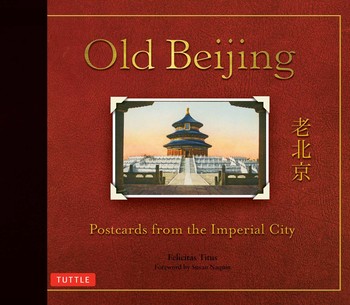
Old Beijing
Postcards from the Imperial City
By Felicitas Titus
Foreword by: Susan Naquin
based on 4 ratings | 1 reviews on Goodreads.com
This collection of Chinese photography contains over 350 vintage postcards from pre-communist China along with extensive historical background and commentary.
Camel trains arriving at a city gate; the distinctive architecture of the Forbidden City, its pagodas, imperial buildings and temples; Manchu fashion, the Empress Dowager and the child emperor Puyi; street performers and foreign tourists—all come to life again in this extraordinary collection of rare and vintage postcards.
Old Beijing: Postcards from the Imperial City offers a unique look at a vanished China and its storied capital once known as Peking. Containing unique black-and-white and hand-tinted cards that span Chinese history from the last years of Imperial China to the Japanese invasion of 1937, it is a treasure trove for historians, collectors, Sinophiles and anyone fascinated by Chinese culture and people from times past.
~~~~
[PDF]評韓書瑞(Susan Naquin)教授《北京:寺廟與城市生活》
idv.sinica.edu.tw/wujs/pdf/MS6ReviewWuJS.pdf
Translate this page
Susan Naquin, Peking: Temples and City Life, 1400-1900, Berkeley: University of ... 作者韓書瑞教授(Susan Naquin)任教於普林斯頓大學東亞系。韓. 教授成名已 ...Translate this page
University of California Press, Dec 16, 2000 - History - 850 pages
The central character in Susan Naquin's extraordinary new book is the city of Peking during the Ming and Qing periods. Using the city's temples as her point of entry, Naquin carefully excavates Peking's varied public arenas, the city's transformation over five centuries, its human engagements, and its rich cultural imprint. This study shows how modern Beijing's glittering image as China's great and ancient capital came into being and reveals the shifting identities of a much more complex past, one whose rich social and cultural history Naquin splendidly evokes. Temples, by providing a place where diverse groups could gather without the imprimatur of family or state, made possible a surprising assortment of community-building and identity-defining activities. By revealing how religious establishments of all kinds were used for fairs, markets, charity, tourism, politics, and leisured sociability, Naquin shows their decisive impact on Peking and, at the same time, illuminates their little-appreciated role in Chinese cities generally. Lacking most of the conventional sources for urban history, she has relied particularly on a trove of commemorative inscriptions that express ideas about the relationship between human beings and gods, about community service and public responsibility, about remembering and being remembered. The result is a book that will be essential reading in the field of Chinese studies for years to come.

沒有留言:
張貼留言